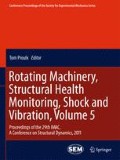Abstract
Output-only modal analysis has been extensively developed in the past decades and widely used especially when the input is unknown or difficult to measure. This paper presents a noncontact experimental technique for measuring the modal parameters of a rectangular aluminum plate using only the output data, with the intention to apply the technique to turbine blades. Operational modal analysis (OMA) is employed to analyze an aluminum plate with free boundaries in the frequency range from 0 to 15000 Hz, which can be an operation frequency range of a turbine blade, under acoustic excitation in the form of white noise in a direction of interest. A single-point laser vibrometer and a free-field microphone are used to simultaneously measure the responses of the plate in a noncontact manner, with the microphone measurement serving as the reference. A cross-power spectral density (CPSD) acquired using the microphone measurement as the reference is shown to be equivalent to that using a laser vibrometer measurement as the reference as long as the natural frequencies of the test structure that are of interest are sufficiently high but lower than a certain value. A measurement method for in-plane vibration modes is also proposed and applied by shining the laser from the vibrometer with a certain incident angle. The natural frequencies and mode shapes of the out-of-plane and in-plane modes of the plate are measured. The experimental natural frequencies and mode shapes of the plate are compared with those calculated using commercial finite element software to demonstrate the validity of the experimental technique. Experimental modal analysis (EMA) is also performed on the plate using an impact hammer and the laser vibrometer to validate the experimental results from OMA. The maximum error between the measured and calculated natural frequencies of the plate is 1.53% for the first 18 elastic modes, including 16 outof-plane plane modes and two in-plane modes. The Modal Assurance Criterion (MAC) values between the corresponding mode shapes of the plate are all above 93%.
Access this chapter
Tax calculation will be finalised at checkout
Purchases are for personal use only
Preview
Unable to display preview. Download preview PDF.
References
Verhees, M., “Experimental Modal Analysis of a Turbine Blade,” Traineeship Report, Technische Universiteit Eindhoven, Netherland, 2004.
James, G., Carne, T., Lauffer J., and Nord, A., “Modal Testing Using Natural Excitation,” Proceedings of the 10th IMAC, San Diego, CA, USA. 1992.
Zhang, L., Brincker, R., and Andersen, P., “An Overview of Operational Modal Analysis: Major Developments and Issues,” Proceedings of the 1st IOMAC, Copenhagen, Denmark, 2005.
Brincker, R., and Andersen, P., “ARMA Models in Modal Space,” Proceedings of the 17th IMAC, Kissimmee, FL, USA, 1999.
Benveniste, A., and Fuche, J., “Single Sample Modal Identification of a Nonstationary Stochastic Process,” IEEE Transaction Automatic Control, Vol. 30(1): 66-74, 1985.
Peeters, B., and De Roeck, G., “Stochastic System Identification for Operational Modal Analysis: A Review,” ASME Journal of Dynamic System, Measurement, and Control, Vol. 123(4): 659-667, 2001.
Brincker, R., Zhang, L., and Anderson, P., “Modal Identification from Ambient Responses Using Frequency Domain Decomposition,” Proceedings of the 18th IMAC, San Antonio, TX, USA, 2000.
Guillaume, P., Verboven, P., Vanlandiut, S., Van der Auwaerer, H., and Peeters, B., “A Poly-Reference Implementation of the Least-Squares Complex Frequency-Domain Estimator,” Proceedings of the 21st IMAC, Kissimmee, FL, USA, 2003.
Ewins, D., Modal Testing: Theory, Practice and Application, 2nd Edition, Research Studies Press Ltd., Baldock, Hertfordshire, England, 1999.
Larsson, D., “In-plane Modal Testing of a Free Isotropic Rectangular Plate,” Experimental Mechanics, Vol. 37(3): 339-343, 1997.
Fahy, F. Foundations of Engineering Acoustics, Elsevier Academic Press, London, England, 2001.
Valentino, M, Microphone Handbook, PCB Piezotronics, NY, USA.
Mohanty, P., “Operational Modal Analysis in the Presence of Harmonic Excitations,” Ph.D. Thesis, Technische Universiteit Delft, Netherland, 2005.
Caughey, T., and O'Kelly, M., “Classical Normal Modes in Damped Linear Dynamic Systems,” ASME Journal of Applied Mechanics, Vol. 32: 583-588, 1965.
Peeters, B., and Van der Auweraer, H., “PolyMAX: a Revolution in Operational Modal Analysis,” Proceedings of the 1st IOMAC, Copenhagen, Denmark, 2005.
Heylen, W., Lammens, S., and Sas, P., Modal Analysis Theory and Testing, Katholieke Universiteit Leuven, Faculty of Engineering, Department of Mechanical Engineering, Division of Production Engineering, Machine Design and Automation, Belgium, 1998.
Author information
Authors and Affiliations
Corresponding author
Editor information
Editors and Affiliations
Rights and permissions
Copyright information
© 2011 Springer Science+Business Media, LLC
About this paper
Cite this paper
Xu, Y.F., Zhu, W.D. (2011). Operational Modal Analysis of a Rectangular Plate Using Noncontact Acoustic Excitation. In: Proulx, T. (eds) Rotating Machinery, Structural Health Monitoring, Shock and Vibration, Volume 5. Conference Proceedings of the Society for Experimental Mechanics Series. Springer, New York, NY. https://doi.org/10.1007/978-1-4419-9428-8_30
Download citation
DOI: https://doi.org/10.1007/978-1-4419-9428-8_30
Published:
Publisher Name: Springer, New York, NY
Print ISBN: 978-1-4419-9427-1
Online ISBN: 978-1-4419-9428-8
eBook Packages: EngineeringEngineering (R0)

